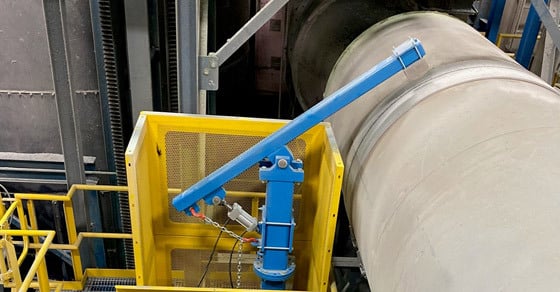Knockers are a valuable tool in minimizing buildup in rotary dryers, coolers, granulators, and coating drums, giving plant managers the opportunity to improve production and product quality.
FEECO has developed the pneumatic hammer knocker to provide a more flexible alternative to the commonly chosen ball and tube knocker style.
About Rotary Drum Knockers
While a few different designs exist, rotary drum knockers all serve the same purpose: to dislodge any potential buildup occurring inside the rotary drum by knocking the drum.
Knocking systems are widely employed in applications where buildup could cause a hazard risk, degrade equipment performance or construction, or compromise product integrity. They are especially useful when processing hygroscopic materials such as potash or gypsum, which are prone to clumping during processing.
The most commonly chosen design for knockers is the ball and tube knocker system. A wear band or plates fitted with several self-contained assemblies, each housing a large ball bearing, are mounted onto the rotary drum. As the drum rotates, gravity causes the ball to fall down the cylinder, hitting the drum at the wear plate.
3D Rendering illustrating the ball and tube knocker design
This style of knocker is simple, effective, and low maintenance.
The FEECO Pneumatic Hammer Knocker
While the ball and tube knocker design is effective and efficient, some applications benefit from more control over the knocking system. For these scenarios, we’ve developed a pneumatic hammer knocker design.
The pneumatic hammer knocker offers a number of improvements on the simple ball-and-tube design. This design consists of a solenoid-activated hammer, mounted above the drum. The hammer is electronically controlled to deliver a knock at predetermined times.
Because the unit is electronically controlled, it is much more flexible, allowing operators to adjust the frequency of strikes, as well as the amount of force they deliver. The unit can also be turned off for noise reduction when it is not needed.
Another benefit to this design is that because strike frequency is adjustable, knocking does not always occur at the same location on the drum as it does with the ball and tube design, increasing the effectiveness of buildup removal.
For easier maintenance access, the pneumatic hammer can be mounted on a structure alongside the drum instead of above it.
FEECO Pneumatic Hammer installed on a rotary drum.
Conclusion
Hammer knockers provide an effective means to reduce buildup in rotary dryers, coolers, granulators, and coating drums. And while the ball and tube knocker design is sufficient for many applications, when enhanced control is necessary, the FEECO pneumatic hammer knocker provides an excellent alternative.
FEECO is the world’s leading manufacturer of custom rotary drums. In addition to new rotary drums and knocking systems, we offer extensive parts and service support for rotary drums, including inspections and audits, repairs and maintenance, and spare parts. For more information on our rotary drums, knockers, or services, contact us today!



